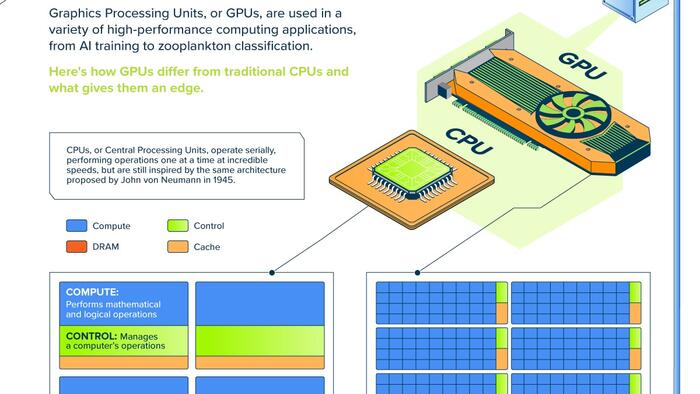


Graphics Processing Units, or GPUs, have moved beyond their original role of rendering video game graphics and are now used in a variety of high-performance computing applications (HPC), from AI training to zooplankton classification.
To help understand this pivot, Visual Capitalist teamed up with HIVE Digital to look at how GPUs differ from traditional CPUs and what gives them an edge.
CPUs, or Central Processing Units, and GPUs, generally have three main elements:
CPUs, or Central Processing Units, typically have one or more extremely powerful cores, made up of independent compute, control, and cache elements. A GPU, on the other hand, has many more less-powerful cores, each with multiple ALUs that share common cache and control elements.
The number of cores is important, especially when it comes to image processing. In order to display an image on your screen, the computer has to read, process, and display data for each pixel, which on modern high-definition displays can really add up. A 1,920 by 1,080 pixel display, for example, has 2,073,600 pixels.
Unlike CPUs, which have to go one operation at a time, GPUs can handle multiple operations like this in parallel, thanks to its multiple-core architecture. Computer scientists call this method of data-handling single instruction, multiple data (SIMD), but all we need to know is that this is why today’s computer games look so much better than 1972’s Pong.
It turns out that GPUs can do more than just render graphics. Researchers are now using GPUs to model protein folding and sequence genomes, while cryptocurrency miners rely on them to validate transactions. GPUs are also playing a critical role in the field of AI, where training datasets are only getting larger.
GPUs are also working side-by-side with CPUs in the world’s only exa-scale computer, Frontier, which uses a combined 8,699,904 GPU and CPU cores to achieve an impressive speed of 1.194 exa-flops per second.
But when you consider that CPUs are still built on roughly the same von Neumann architecture from 1945, it’s perhaps no surprise that new specialized designs, like the GPU, are emerging to help us tackle some of the world’s toughest HPC challenges.
Learn how Hive Digital’s renewably powered GPUs are helping customers worldwide meet their high-performance computing needs.
